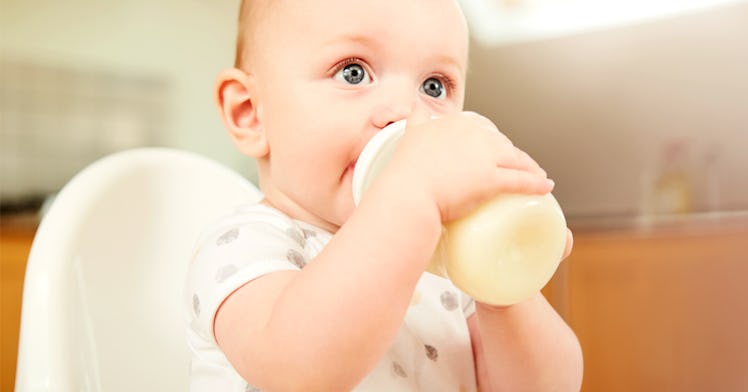How to Choose the Right Bottles and Nipples
You haven't been comparison shopping until you've waded through the dozens of options out there for bottles and nipples. Here's your cheat sheet.

This story first appeared on HappyFamilyOrganics.com.
Whether you’re feeding your little one formula or expressed breast milk, navigating the wide selection of bottles and nipples can be a daunting task. As every baby is different, bottles and nipples are certainly not one-size-fits-all. It may take some experimenting to find what works best for you and your baby.
Bottle Materials
Many parents are switching to glass bottles because of concerns about chemicals found in plastic ones. Glass may seem impractical for a baby — it tends to be heavy for little hands (not to mention for carting around town) and more likely to break — but you can purchase protective sleeves, so they are easier to grip and less likely to shatter if (and when!) they drop.
Know, however, that the FDA no longer allows the use of bisphenol A (BPA) in baby bottles, so what was once a major concern when it came to plastic bottles is no longer an issue. With any type of plastic, avoid microwaving, and discard if the bottle turns cloudy.
Silicon is a third option. Newer companies are utilizing silicon to avoid lingering fears over plastic as well as the impracticalities of glass.
There are also stainless-steel bottles available, though these are more expensive and difficult to find. While they are durable, it is difficult to see how much milk is in the bottle.
Bottle Types
- Angle-neck bottles are bent at the neck so that less air is formed in the nipple. Some parents think these are easier to hold as well. However, the design makes them a little harder to clean.
- Disposable-liner bottles come with a plastic pouch that fits inside the bottle. As your baby drinks from the bottle, the plastic collapses to prevent the formation of air bubbles (which can turn into gas in your little one’s tummy). They are convenient (less cleaning!), but not as eco-friendly and the liners can get expensive if you’re exclusively bottle-feeding.
- Vented bottles have a straw-like vent that goes through the center. The design aims to eliminate air bubbles that can cause gas. Despite a lack of evidence that these reduce gas and colic, many parents swear by them. Keep in mind, though, that these extra parts do mean extra cleaning.
- Wide-mouth bottles are shorter and wider than typical bottles. They also use wider nipples that tend to better mimic the breast. If you are nursing and bottle-feeding, your baby may prefer the feel of this bottle best – but not always! These bottles tend to be easier to clean.
Bottle Sizes
Bottles typically come in 4-ounce and 8-ounce sizes. Start small when your baby is a newborn and use larger bottles once your baby starts to consume more milk at each feeding.
Nipple Material
Most nipples are made of clear silicone, which are flexible and not damaged by heat when washed or boiled. However, some nipples are made with latex, which could cause an allergic reaction in sensitive infants, so it’s best to avoid these.
Nipple Shapes
Nipples are designed to imitate a mother’s nipple and are available in different shapes. Standard nipples are long with a narrow base and are typically easy for baby to use. Other nipples have a wider base with varying nipple lengths. Often times, babies who are breastfeeding will prefer the wider-based nipples, but you may have to do some experimenting to learn your baby’s preference.
Nipple Flow Rates
Bottle nipples come with different-sized openings for milk to flow through. Nipples are labeled with level numbers indicating the flow rate, with a “level 1” nipple being the slowest (smallest opening) and a “level 4” being the fastest (largest opening). Most newborns will do well with a “level 1” nipple. But, all babies are different, so if your baby is frustrated with a slower feeding pace, try switching to a “level 2” nipple. As your little one continues to grow and becomes even more efficient at feeding, she can graduate to the next nipple level — typically every 3 months.
What to Do
Try a variety of bottles and nipples
Babies can be quite picky about the bottle and nipple they prefer, so avoid buying one type of bottle in bulk. Instead, purchase a few different kinds of bottles and nipples that fit together.
Test a bottle a few times before moving on
Start with one type of bottle and allow your babe to try it several times – don’t give up if your little one rejects it the first time. Give your baby enough chances to try one type of bottle or nipple before switching to a new one since constantly changing could lead to even more frustration.
It may take some experimenting before deciding which bottle and nipple works best for your baby.
For questions on anything bottle related, you can chat live with a Happy Mama Mentor – Happy Family’s team of registered dietitians, lactation specialists and all moms!
This article was originally published on